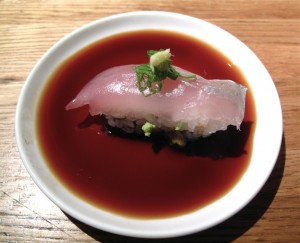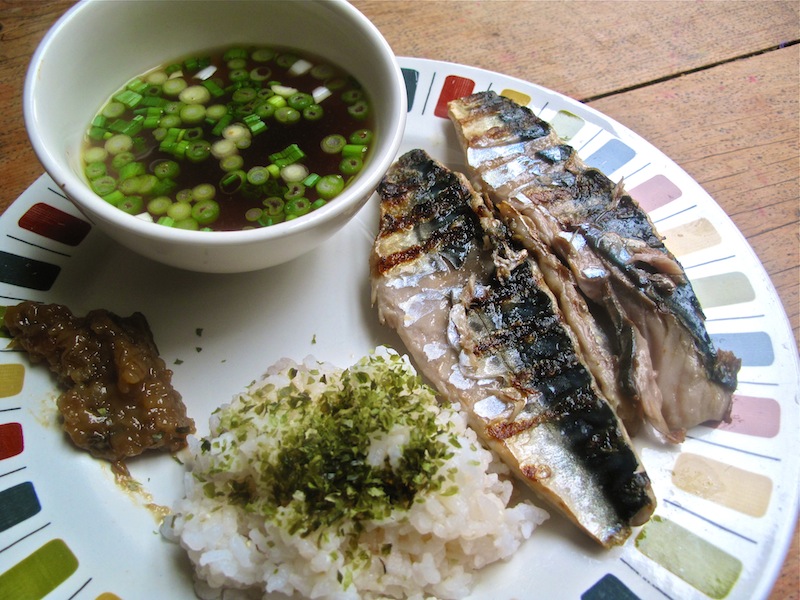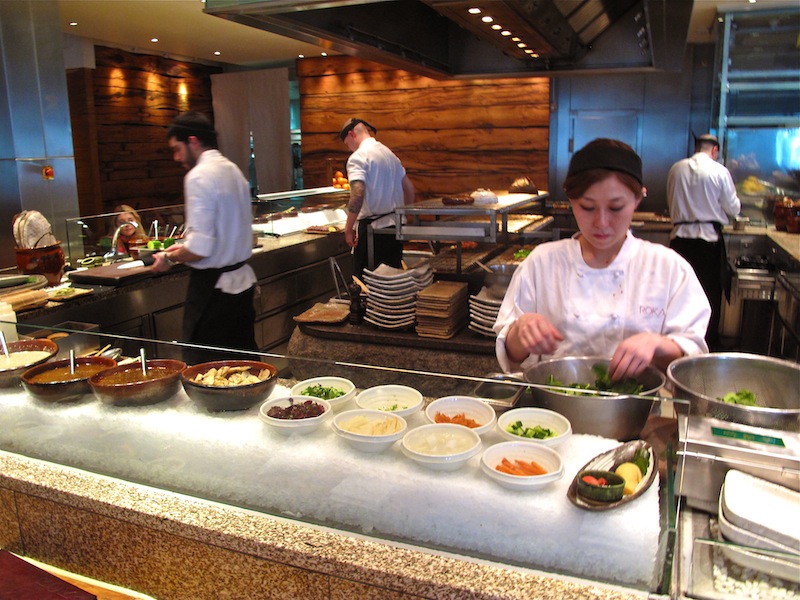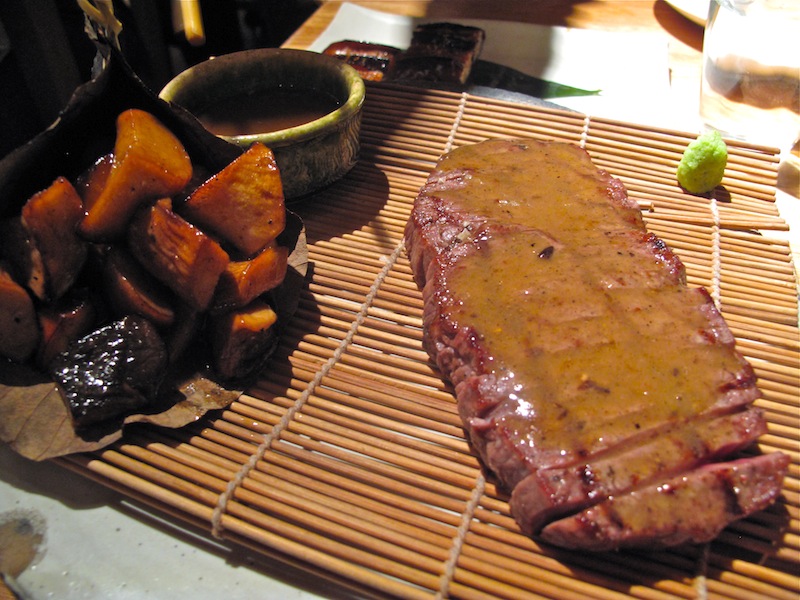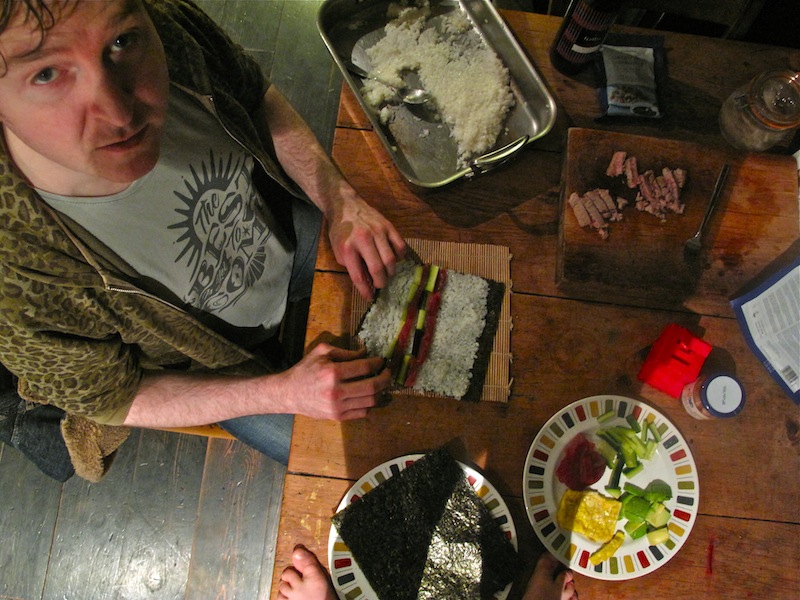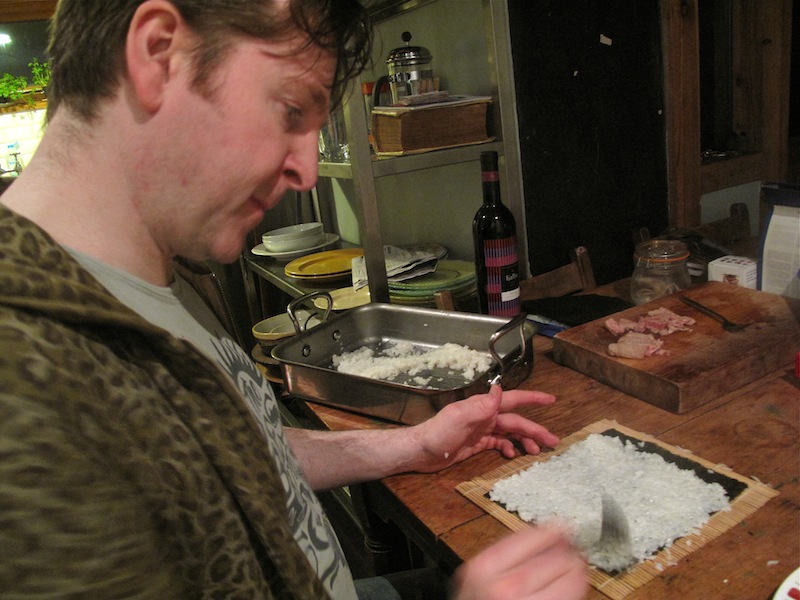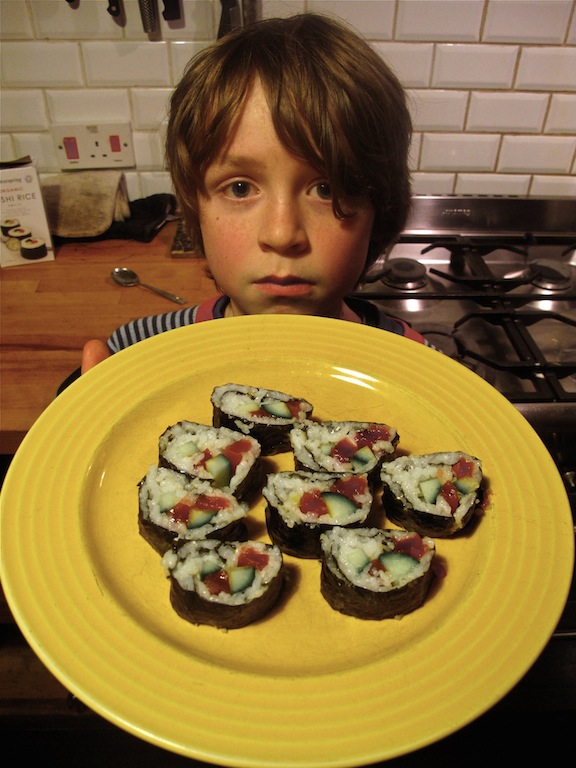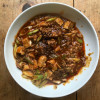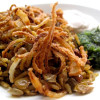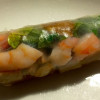Week five – and our randomly chosen country is Japan! It’s one of the “big” cuisines of the world and a slightly daunting culinary challenge to cook at home due to the difficulty in getting really top grade fish and the specialist nature of some of the ingredients.
Fortunately we were able to do a massive fudge of the rules of Round The World Cooking and just go out for meals instead. We’d booked in a trip to London ages before so we had no option but do our Japanese extravaganza there.
Breakfast – Grilled Fish With Natto
We covered off lunch and dinner in London but I felt I was letting everyone down by a) missing breakfast and b) not doing any cooking. At time of writing I am recovering from a Rioja induced hangover after cooking Spanish food all day yesterday and getting through about a dozen or so tapas dishes.
I felt lousy this morning but compelled to follow through on the mission – and so at 7.45 I was gutting a mackerel and preparing myself for my first encounter with natto.
When it came to deciding our menu I pretty much knew what to have for lunch and dinner but had no idea what constituted a Japanese breakfast.
Mark Cratchley who lived in Japan for many years said:
“Traditional breakfast is miso soup, grilled fish and rice with nori, soy sauce and natto, which is fermented soy beans and is rather an acquired taste. The Japanese equivalent of Marmite. For the lovers it’s a wonderfully textured, extremely healthy staple. For the haters it’s puke-smelling lumpy slime. Ganbatte!”
Intrigued I wanted to find out more so I asked my Japanese friend for advice:
“A typical Japanese breakfast would include rice, natto, raw eggs, grilled fish, pickle and miso soup. I like it but I’d say it is quite acquired taste.”
“Acquired taste” generally means it’s rotten but what is natto? Basically it’s a slightly slimy, pungent relish made from fermented soybeans. Variously described as smelling like nappies, old socks or (as above) puke, it’s not surprising perhaps that natto is not widely consumed by Westerners who prefer things that are variously described as “sweet”, “delicious” and “moreish”, like donuts or pancakes.
Visit the website NattoKing and you can see that the process of making it at home looked pretty complicated, especially given you need a specific bacterial culture (bacillus subtilis) to make it work. If you want to try at home visit their site. I chose to buy mine online from Clear Spring and mitigate the risk of severe gastro enteritis.
Natto has a long history in Japan, with origins as far back as 1000BC, so one can only assume that like fish sauce, rotten shark or really stinky cheese someone does actually like eating the stuff. It’s also supposed to be really good for your health being highly alkaline and containing a substance called pyrazine which is claimed to reduce blood clotting. It’s also very high in Vitamin K, which I thought was a street drug with a bad rep, but what do I know?
So back to this morning when at 7.45 I was elbow deep in fish guts and preparing seaweed and a slimy gunge that smells of nappies for my breakfast. The prospect was not appealing but I was pleasantly surprised. Natto does have quite a strong flavour – but mitigated with the blandness of rice and an umami smack of soy sauce it’s nutty, tangy and verging on delicious.
As a massive fan of Heston Blumenthal, I’m aware that barely a sentence passes without the food wizard mentioning the word umami.
For centuries, scientists claimed there were only four basic tastes that human beings could perceive – Sweet, Sour, Bitter and Salty. But at the turn of the century Kikunae Ikeda of Tokyo Imperial University discovered that there was a compound called glutamate that gave rise to another distinct taste that he called “umami”.
Best described as “savoury”, the umami taste is a characteristic of a lot of Japanese food including Shitake mushrooms, dashi broth, seaweed and fermented products like soy sauce.
Speaking of soy, it’s remarkable how versatile one bean can be. High in protein, (double the amount of other beans) and oil, they’re not widely eaten boiled up like other beans as they stay quite firm even after cooking and can smell unpleasantly beany.
Instead soy is eaten young and fresh (edamame), made into milk and bean curd or fermented to make soy sauce, miso (made by fermenting rice and then mixing with ground soy beans and leaving for months, or even years), tempeh (layers of whole soy beans fermented quickly in a warm temperature) and natto, mentioned above.
There is no shortage of strange and sometimes death-defying recipes in Japanese cuisine but these days many dishes are commonplace in the UK. Twenty years ago the idea of eating raw fish would have be the subject of mock outrage in some primetime ITV sitcom. Now, since the ubiquity of Yo! Sushi and Wagamama, pretty much everyone accepts sushi, noodles, dumplings etc as standard High St fare.
Because I’m obtuse and like mixing things up, I wanted to include something less well known: okonomiyaki. The name roughly translates as “a little bit of what you fancy – grilled” and they’re a bit like a pizza, a pancake and an omelette rolled in to one. Made from flour, grated nagaimo (a kind of yam), dashi (see below), eggs, shredded cabbage and the filling of your choice –(noodles, pork, shrimp, kimchi, octopus, chicken, pretty much anything), they’re cooked in front of you on a hot plate in the centre of the table.
We had them at Abeno near the British museum – I don’t know of anywhere else in London you can try them but the mixture is pretty easy to replicate at home. You can see the whole process here.
 Katsuobushi – the most complicated ingredient in the world?
Katsuobushi – the most complicated ingredient in the world?
There are many ways to preserve fish but possibly the most extreme is Katsuobushi which goes through four different methods before the final product is ready. Made from skipjack tuna, the process starts with boiling strips of the flesh in brine for an hour then skinning. Then strips are hot smoked for anything up to three weeks until the flesh has gone completely hard. Then the meat is exposed to several moulds and put in a box to ferment for a couple of weeks. The fish is then sub-dried for 24 – 48 hours and the mould scraped off. The moulding process is then repeated until the meat is like a piece of wood.
The final product is usually shaved into wafer-thin flakes and used as the basis of dashi broth (a soup/stock that’s used in several Japanese dishes including miso soup) and as a flavouring in its own right, as in okonomiyaki above.
I had lots of recommendations for Japanese food in London. Umu is widely acclaimed for its tasting menu and prices; Nobu is also pricey and given the eclectic influences not as authentic as I was looking for.
Given the choice I would have headed to Sukiyabashi-Jiro in Tokyo, the Three Michelin star sushi bar in a Tokyo metro station run by 87 year old Jiro Ono. If you haven’t seen the film check it out. Jiro is one of those passionate, some would say obsessive, chefs who has taken the art of sushi making to impossible levels of perfection.
The closest I could find in London is Sushi Tetsu in Clerkenwell, which was recently featured in Observer Food Monthly and already has a three-month waiting list but with only a week to go that wasn’t going to cut it, even though it was the only restaurant in London recommended by my Japanese friend Aiko.
Instead we plumped for Roka in Charlotte St. With interiors by the fantastically named Super Potato Architecture, it felt extremely cool to Devon bumpkins like us but relaxed enough for a dad and his 9-year old son to chill out over some raw fish.
All the prep takes place in the centre of the restaurant, with a robata grill, a large grill that uses white beech wood and reaches extremely high temperatures, at the centre.
A total sucker for anything novel, I ordered a special Jasmine infused plum wine with hand-cut ice. “Hand-cut ice” I ask you! The next thing they’ll be trying to sell me is hand-massaged beef… oh.
Wagyu Beef
Before I write about eating one of the most expensive ingredients in the world I have to say that, while I enjoy eating out I only very, very rarely spend ridiculous amounts of money on food. I take my responsibilities very seriously and just as I had to endure the natto, I needed to try the Wagyu Beef on behalf of my readers.
Wagyu beef is known for its richly marbled quality – and for the fact that farmers routinely feed Wagyu cattle on beer and massage them. Kobe is a type of Wagyu beef.
I’m embarrassed to admit in a time of recession that my Wagyu steak cost £70. It was a fantastic piece of meat – meltingly tender and packed with flavour – but in my opinion not significantly better than say Angus or Devon Ruby to warrant the price tag. In fact, having cooked a Brazilian weekend I could have bought 4 kilos of picanha (top rump joint) for the same price and fed about 16 people – a much better deal!
Home Sushi
I could go into raptures about the sushi, the gyoza and the tempura at Roka but I won’t. It was lush and my boy ate his own body weight of the stuff. It’s strangely satisfying seeing your child relishing sushi. To my generation, eating sushi feels almost like listening to punk rock – it marks us out from our parents’ generation.
When my kids ask for sushi, it feels like we’ve crossed some kind of culinary Rubicon. I imagine that they will feel the same when their kids demand insects and snails for lunch, which to me the idea of eating recalls the immortal line of Crocodile Dundee “you can live on it but it tastes like shit.”
Anyway, I digress. Given the blatant cheating going on in this blog I felt obliged to make sushi at home. It’s not as much of a palaver as you might think but requires some forethought. As is true with most dishes (and perhaps even of life in general) the quality and authenticity of the ingredients you use are going to dictate the success of the outcome.
One thing that’s absolutely essential of course is very fresh fish. You sometimes see fish described as “sushi grade” but what does that actually mean? According to EU law, any fish that is going to be eaten raw must be frozen at -20 degrees C or less for at least 24 hours.
How to make maki roll sushi (strictly speaking Futomaki as mine had more than one filling)
- 2 x nori sheets
- 250g sushi rice
- 3tbsp brown rice vinegar
- 3 teaspoons salt
- 1tsp mirin
- 5 tsp sugar
- optional konbu seaweed
First rinse the rice thoroughly then soak in cold water for around 30 minutes.
While the rice is soaking combine 2 tbs of the vinegar with the salt, mirin and sugar in a small pan on a medium heat until all the sugar dissolves. When the sugar is totally dissolved add a small piece of konbu if using. Once the liquid is cool add the last tbs of vinegar.
Once the rice has soaked, Drain and then add to a pan with 300 ml cold water. Bring to the boil over high heat and boil for 1 minute. Then turn down to a bare simmer and cook for 5 minutes. Add water at any stage if the rice is getting too dry.
Increase the heat for a final minute and then take off the heat and leave in the water for 15 minutes. Drain.
While still warm, spread the rice out in a baking tray and sprinkle with half the vinegar mixture. Mix this through by turning the rice over with a wooden spatula or similar – basically you want to damage the rice grains as little as possible. Add the other half and mix through.
Fillings
- Sushi grade fish (we used tuna)
- Avocado strips
- Omelette strips
- Cucumber strips
You need to cut your ingredients into rectangular strips.
Put the nori sheet in front of you on your sushi rolling mat shiny side down.
Spread thinly with rice leaving a gap of around 1 inch at the top of the sheet.
Lay the ingredients in thin strips across the rice around 1 inch from the bottom of the sheet.
Roll gently from bottom to top.
Cut the roll into around 8 pieces with a sharp, wet knife.
If you want to see pictures of the process check out: http://makemysushi.com/
And if you want to buy sushi grade fish online visit: http://kazari.co.uk
Tunes – as chosen by Drift Records:
http://thedriftrecordshop.net/products/shugo-tokumaru-in-focus
